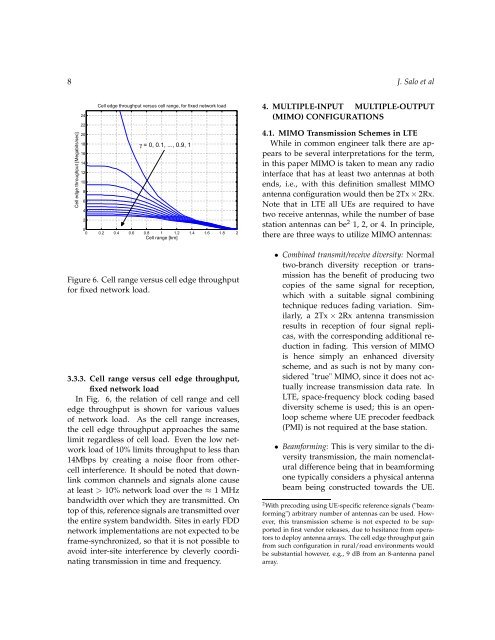8 J. Salo et alCell edge throughput [Megabits/sec]24222018161412108642Cell edge throughput versus cell range, for fixed network loadγ = 0, 0.1, ..., 0.9, 100 0.2 0.4 0.6 0.8 1 1.2 1.4 1.6 1.8 2Cell range [km]4. MULTIPLE-INPUT MULTIPLE-OUTPUT(MIMO) CONFIGURATIONS4.1. MIMO Transmission Schemes in <strong>LTE</strong>While in common engineer talk there are appears<strong>to</strong> be several interpretations for the term,in this paper MIMO is taken <strong>to</strong> mean any radiointerface that has at least two antennas at bothends, i.e., with this definition smallest MIMOantenna configuration would then be 2Tx×2Rx.Note that in <strong>LTE</strong> all UEs are required <strong>to</strong> havetwo receive antennas, while the number of basestation antennas can be 2 1, 2, or 4. In principle,there are three ways <strong>to</strong> utilize MIMO antennas:Figure 6. Cell range versus cell edge throughputfor fixed network load.3.3.3. Cell range versus cell edge throughput,fixed network loadIn Fig. 6, the relation of cell range and celledge throughput is shown for various valuesof network load. As the cell range increases,the cell edge throughput approaches the samelimit regardless of cell load. Even the low networkload of 10% limits throughput <strong>to</strong> less than14Mbps by creating a noise floor from othercellinterference. It should be noted that downlinkcommon channels and signals alone causeat least > 10% network load over the ≈ 1 MHzbandwidth over which they are transmitted. On<strong>to</strong>p of this, reference signals are transmitted overthe entire system bandwidth. Sites in early FDDnetwork implementations are not expected <strong>to</strong> beframe-synchronized, so that it is not possible <strong>to</strong>avoid inter-site interference by cleverly coordinatingtransmission in time and frequency.• Combined transmit/receive diversity: Normaltwo-branch diversity reception or transmissionhas the benefit of producing twocopies of the same signal for reception,which with a suitable signal combiningtechnique reduces fading variation. Similarly,a 2Tx×2Rx antenna transmissionresults in reception of four signal replicas,with the corresponding additional reductionin fading. This version of MIMOis hence simply an enhanced diversityscheme, and as such is not by many considered"true" MIMO, since it does not actuallyincrease transmission data rate. In<strong>LTE</strong>, space-frequency block coding baseddiversity scheme is used; this is an openloopscheme where UE precoder feedback(PMI) is not required at the base station.• Beamforming: This is very similar <strong>to</strong> the diversitytransmission, the main nomenclaturaldifference being that in beamformingone typically considers a physical antennabeam being constructed <strong>to</strong>wards the UE.2 With precoding using UE-specific reference signals ("beamforming")arbitrary number of antennas can be used. However,this transmission scheme is not expected <strong>to</strong> be supportedin first vendor releases, due <strong>to</strong> hesitance from opera<strong>to</strong>rs<strong>to</strong> deploy antenna arrays. The cell edge throughput gainfrom such configuration in rural/road environments wouldbe substantial however, e.g., 9 dB from an 8-antenna panelarray.
<strong>Practical</strong> <strong>Introduction</strong> <strong>to</strong> <strong>LTE</strong> <strong>Radio</strong> <strong>Planning</strong> 9This requires closely spaced antennas, unlikethe diversity schemes which requireat least a few wavelength antenna spacing.Beamforming using 3GPP codebook alsorequires PMI feedback from UE. Mathematically,both beamforming and transmitdiversity are both special cases of so-calledrank-1 precoding 3 . <strong>LTE</strong> Rel 8 supportsrank-1 precoding (or, "beamforming") usingpre-defined 3GPP codebook (for 2and 4 antennas), and any vendor-specificbeamforming when using UE-specific referencesignals (arbitrary number of basestation antennas).• Spatial Multiplexing: This is what manyconsider <strong>to</strong> be a true MIMO transmissionscheme. With beamforming and diversity,base station transmits a single stream ofinformation but uses the multiple antennas<strong>to</strong> either reduce fading (diversity) orincrease signal power (beamforming). Onthe other hand, with 2Tx × 2Rx spatialmultiplexing the idea is <strong>to</strong> transmit twoparallel information streams over the samebandwidth, hence theoretically doublingthe data rate and spectral efficiency. Bothopen-loop (only channel rank and CQIreported by UE) and closed-loop spatialmultiplexing are supported (also precodingmatrix information reported by UE).Delving slightly in implementation details,in <strong>LTE</strong> open-loop spatial multiplexinghave been engineered in such a waythat symbols in information streams areinterleaved between the MIMO subchannels.Thus, the average SINR experiencedby the transmitted symbols is the averageof the two MIMO subchannels’ SINRs.In uplink, spatial multiplexing is not supportedfor a single UE, but two differentUEs are allowed <strong>to</strong> transmit at the sametime; this is called multiuser-MIMO.3 In this paper, rank-1 precoding and beamforming are consideredsynonymous.In practice, the choice of transmission schemedepends on instantaneous radio channel conditionsand is adapted continuously. The main difference<strong>to</strong> non-MIMO transmission that, in addition<strong>to</strong> SINR, now also the channel rank has<strong>to</strong> be considered, since spatial multiplexing isfeasible only if the instantaneous radio channel(during 1ms TTI) supports transmission ofmore than one information stream, or in termsof matrices, the 2Tx×2Rx matrix channel’s conditionnumber and SINR are good enough. As arule of thumb, in a spatially uncorrelated channelspatial multiplexing becomes useful whenSINR > 10 dB. Looking at Fig. 3 one can seethat this requires very low network load for spatialmultiplexing <strong>to</strong> work at cell edge, assumingthat other-cell interference is uncoordinated.4.2. Benefit of MIMOThe benefits of different MIMO schemes indownlink are roughly as follows:Transmit/receive diversity: Compared <strong>to</strong> 1Tx×1Rx the gain of 2Tx × 2Rx is about 6 − 7 dBdue <strong>to</strong> following fac<strong>to</strong>rs: i) transmit power isdoubled by adding another amplifier (3dB); ii)average received signal power is doubled becauseof two-antenna reception (3dB); iii) diversityfrom four signal paths brings additionalgain which however strongly depends on thepropagation environment (here pessimisticallyassumed 0−1dB, higher gains are possible).Rank-1 precoding: For slow-moving UEs thegain from closed-loop transmit diversity is 1−2 dB higher than with the open-loop transmit/receivediversity. For fast-moving mobilesthis improvement over diversity diminishes, orgoes negative, since the CQI feedback cannottrack the channel fast enough.Spatial multiplexing: This scheme does not improvelink budget, but increases data rate. Withtwo antennas and an ideal MIMO radio channel,the data rate would be doubled. In practice,gains are considerably smaller due <strong>to</strong> the factthat for ideal operation the SINR of the two parallelsubchannels should be high enough <strong>to</strong> supportthe same modulation and coding scheme.





![optika tervezés [Kompatibilitási mód] - Ez itt...](https://img.yumpu.com/45881475/1/190x146/optika-tervezacs-kompatibilitasi-mad-ez-itt.jpg?quality=85)










